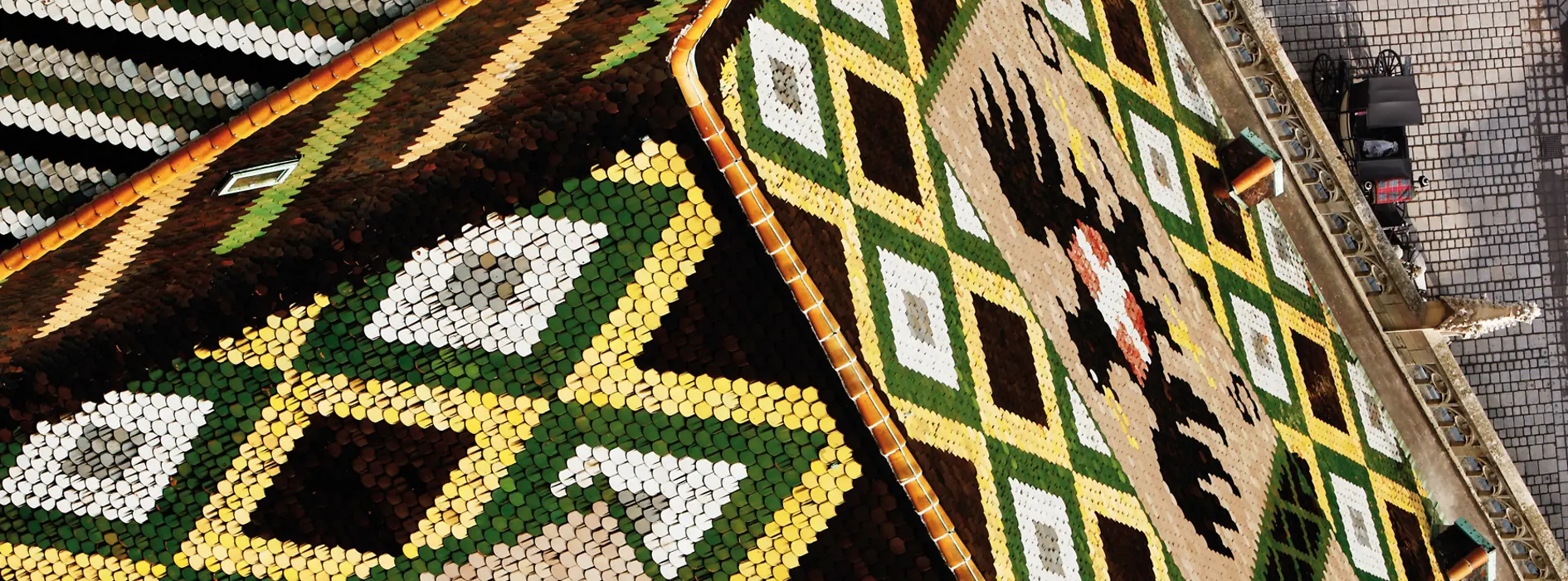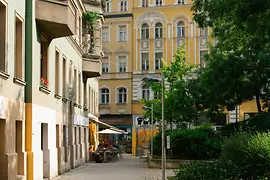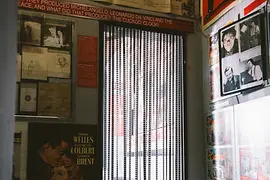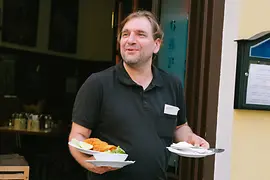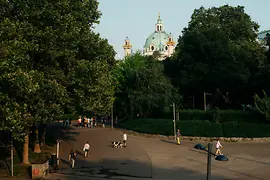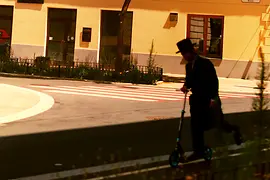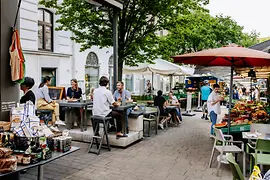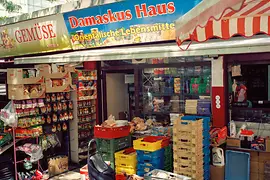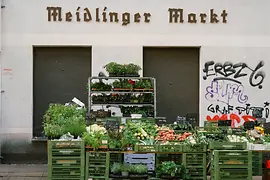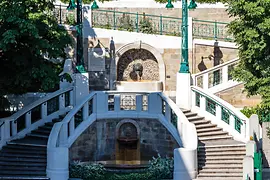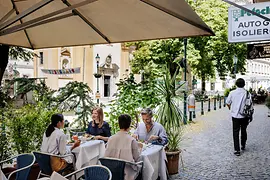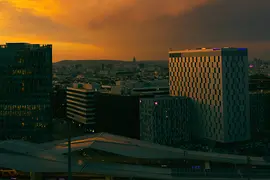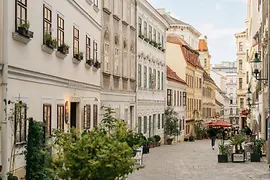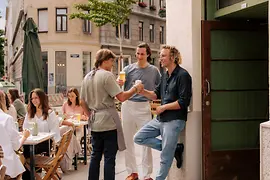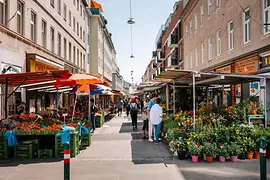Vienna Media News – September 2023 Heartbeat Streets. Fall in Love with Vienna’s Neighborhoods.
In Berlin the word is Kiez, New York has its neighborhoods, Madrid its barrios – while Vienna’s districts are referred to as “Grätzel”. Originally derived from the obsolete word “gereiz”, which meant “perimeter”, it describes a small, inner-city unit consisting of several streets. Most of the Grätzel emerged from the former settlements outside what was then the city center and is now the first district. The centers of these Grätzel are mostly defined by markets or main squares, as well as by the streets leading to them. What makes Vienna’s Grätzel unique is that they often have no official boundaries, no beginning and no end.
Even if there are some common features, each district has a unique combination of architecture, urban feeling, culinary and shopping offerings and, above all, people. Each Grätzel has its own attractions, its particular crowd, its unique character and charm. It is precisely these elements that are responsible for making the world-renowned Viennese attitude to life so tangible in each neighborhood. Each plays a role of its own for both residents and visitors in cosmopolitan Vienna.
Temporary neighbors: dive into local communities
What makes a Grätzel unique is a sense of togetherness. This is not reserved just for residents. In Vienna’s Grätzel, you are a temporary neighbor and not just a visitor. Here you can feel like a true Viennese and discover the authentic Vienna. Vienna’s Grätzel are places to meet, where the city shows itself to be a modern, diverse and liberal-minded metropolis.
Guests are still very much welcomed in Vienna – the acceptance of tourism among the residents of Vienna has remained consistently high for many years. Since 2017, the Vienna Tourist Board has been surveying more than 3,600 Viennese residents on their attitudes towards tourism. The results show that nine in ten Viennese residents see tourism in the city in a positive light. (In 2022, a representative study was conducted by the independent market research company Manova on behalf of the Vienna Tourist Board)
Jewish culture, modern architecture and Viennese originals
In 2024, the spotlight will shine on eleven unique Grätzel that could not be more different from each other (in alphabetical order):
- Freihausviertel (4th district) – a creative cosmo: Just a stone’s throw from the Naschmarkt, this Grätzel with its laid-back stores and eateries is a hot-spot for Vienna’s creative scene. Modern galleries on Schleifmühlgasse and trendy shops create a lively combination. The reputation of the Café Anzengruber precedes it. Stefanie Herkner is a Viennese native and offers cuisine to match in her restaurant Zur Herknerin. This neighborhood is also home to the Third Man Museum. The legendary Freihausviertelfest takes place every year at the end of June.
- Gußhausviertel & Karlsplatz (4th district) – Gründerzeit (“the age of the founders”) and Viennese history: The spectacular new Wien Museum (opening on December 6, 2023) and the baroque Karlskirche (Church of St. Charles) constitute the entrée for this neighborhood, which is dominated by Gründerzeit architecture. The eponymous Gußhaus, a cannon foundry, was built in 1750. Today it is an institute of the city’s Technical University. Its culinary delights range from international gourmet cuisine at Z’SOM to traditional Viennese fare at Gasthaus Buchecker & Sohn.
- Karmeliterviertel (2nd district) – cool and kosher: This neighborhood is still home to a lively Jewish community to this day. Jewish history is tangible on every street corner. There are outstanding culinary offerings at the Karmelitermarkt in the heart of the Grätzel and in the streets surrounding it: Tewa serves organic oriental-Mediterranean cuisine, while Skopik & Lohn specialises in cold bar food and one of Vienna’s most legendary schnitzels. The Museum of Crime awaits devoted crime fans, while the baroque Augarten caters to those in search of relaxation.
- Kutschkermarkt (18th district) – sophisticated and organic: It is one of the last remaining street markets in Vienna and is located in the up-market 18th district. It is particularly worth a visit on Saturdays, when the permanent market stalls are joined by farmers from the surrounding region selling their produce, which ranges from fruit to fish and is often grown or reared organically. The farmers’ market is undergoing expansion as part of a project due for completion in autumn 2023. The upper end of the family-friendly market has been landscaped, pedestrianized and thereby made more climate-friendly. Atlantis Fish runs a restaurant here in addition to a market stall. The best place to watch the hustle and bustle is from the garden of Café Himmelblau. The new Kutsch market restaurant opened at the beginning of September.
- Meidlinger Markt (12th district) – rugged charm: The Meidlinger Markt is a distinct contrast to the Kutschkermarkt. This is where you will find the authentic face of Vienna. Located in the inner-city working-class Meidling district, in addition to traditional market stalls it also offers a gourmet restaurant: the Wirtschaft am Markt takes inspiration from the atmosphere of this Grätzel and offers Viennese cuisine with an oriental touch. Here’s a tip for you: the Meidlinger Markt is located on the route to Schönbrunn Palace, making it a perfect stop-off point for a short rest from sightseeing.
- Seestadt (22nd district) – a lakeside utopia: A neighborhood of the future is currently being built in Donaustadt. It is expected that more than 25,000 people will live and work in the area surrounding the eponymous swimming lake by the 2030s. Alongside the Ariana Eventlocation, the area is also home to the HoHo Wien, the world’s second-tallest wooden high-rise building at 84 meters tall. The area’s culinary offerings are also outstanding, for instance at Café Leo and See22. Owner Johannes Kößler will give you the best advice at his Seeseiten bookstore. Book deliveries are carried out sustainably by bicycle.
- Servitenviertel (9th district) – Paris in miniature: This picturesque French-inspired neighborhood is situated not far from the Sigmund Freud Museum. At the heart of the Grätzel is Servitengasse, which is currently being pedestrianized and landscaped before its reopening in November 2023. The historic houses are particularly well-preserved, and numerous beer gardens and (French-style) pubs are to be found on the ground floors. It’s no wonder that “bon vivants” enjoy this neighborhood.
- Sonnwendviertel & Quartier Belvedere (10th district) – urban development is on track: urban development is progressing at a fast pace in the vicinity of Vienna Central Station. The Sonnwendviertel is a residential area that meets all the requirements of a modern metropolis. The 70,000 m² Helmut-Zilk Park forms the green heart of the area. There is plenty of good food to choose from: Mimi im Stadtelefant, the Feldhase (vegetarian cuisine) and Bio Mio (locally grown produce).
The modern architecture of the Quartier Belvedere on the other side of the station is impressive. Renowned Italian architect Renzo Piano (whose projects include the Centre Pompidou in Paris, among others) has also made his mark in Vienna with the Belvedere Parkapartments. The Belvedere 21 museum is the contemporary offshoot of the eponymous palace and world-famous Belvedere Museum. - Spittelberg (7th district) – Biedermeier paradise: The Christmas market (from 2023 classified as an “eco-event”) in Vienna’s best-known and almost car-free Biedermeier district is particularly popular. However, the Grätzel - which is located immediately behind the MuseumsQuartier and the Volkstheater - is appealing all-year round, with its romantic streets and houses, and numerous food and drink establishments. These include Tian Bistro, an offshoot of the Michelin-star chef Paul Ivić’s Tian restaurant, and &flora restaurant by award-winning chef Parvin Razavi.
- Stuwerviertel & Prater (2nd district) – unadorned Vienna: this area was once home to the red light district. Today, the Stuwerviertel near Messe Wien is a modern neighborhood with lots of eateries (including Mochi am Markt and Brösl) and the Vorgartenmarkt. Adjacent to the district, separated only by the Ausstellungsstraße, is the Vienna Prater. For those seeking entertainment, the Wurstelprater amusement park with its numerous rides is a must-visit. This is also where the new Prater Museum is scheduled to open in March 2024. For those looking for relaxation, the Grüner Prater park is the perfect place to unwind.
- Yppenviertel (16th district) – “Orient and Occident” - where East meets West: The area around Yppenplatz, which features a wealth of food and drink establishments, is one of the most colorful parts of Vienna. More than 400 art events take place in the Brunnenpassage every year. With more than 170 stands, the neighboring Brunnenmarkt is the largest street market in Vienna. The neighborhood has a tangible oriental atmosphere, with plenty of Turkish stands and stores to be found hereabouts. You will find Syrian snack bars, African butchers, and Viennese delis all in close proximity. This neighborhood is truly the city’s heartbeat.
For even more information about “Heartbeat Streets. Fall in Love with Vienna’s Neighborhoods”, please visit www.heartbeat.wien.info
Contact
Helena Steinhart
Media Relations
+43 1 211 14-364
helena.steinhart@vienna.info
